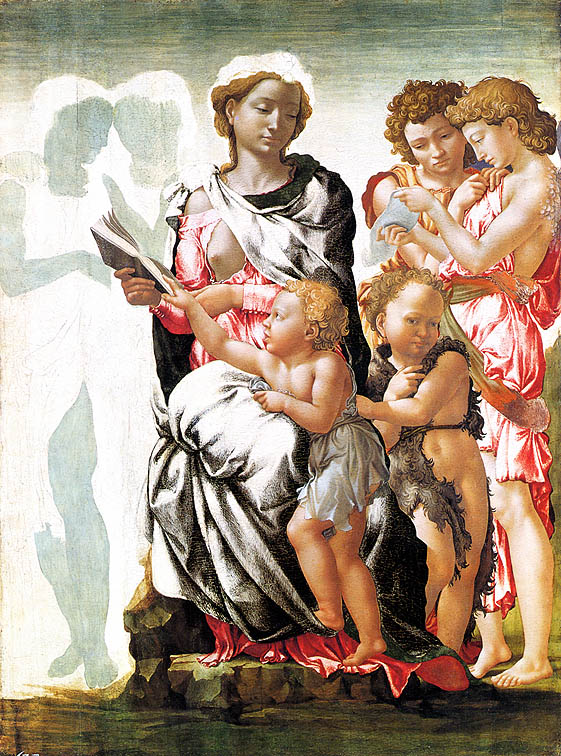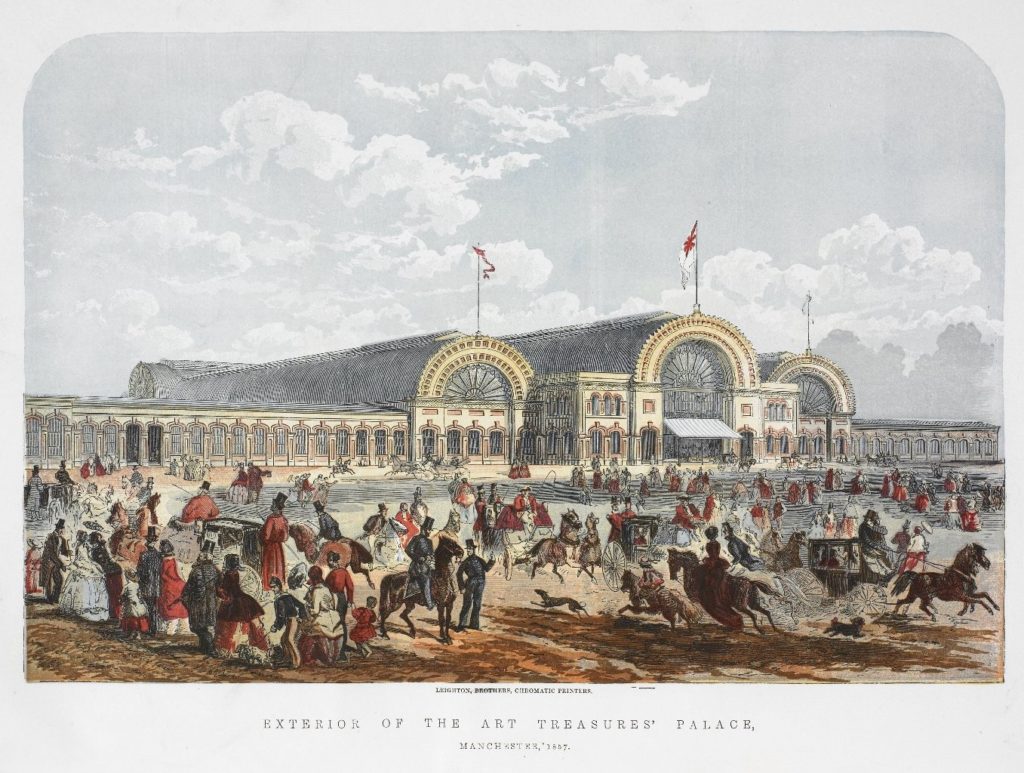The Manchester Art Treasures Exhibition of 1857 was a display of fine art held in Manchester, the “shock city of mid-Victorian England”, from 5 May to 17 October 1857.[1] It remains the largest art exhibition ever held in the United Kingdom, with more than 16,000 works on display, attracting more than 1.3 million visitors,[2] about three times the population of Manchester at that time.[3] The legacy of the exhibition can be seen in the establishment of other northern municipal galleries in the 1870s and ’80s, and the establishment of the Manchester Art Gallery in 1882.[4]
The decision to include daily musical performances led to Charles Hallé forming an orchestra, the Hallé, the oldest in England.[5] After the exhibition’s closure the orchestra continued to perform at the Free Trade HallPublic hall constructed in 1853–1856 on St Peter's Fields, the site of the Peterloo Massacre, now a Radisson hotel. in Manchester.[a]The Hallé orchestra is now based at the Bridgewater Hall in Manchester.
Background
The idea for an exhibition in Manchester was first expressed in a letter sent on 10 February 1856 by John Connellan Deane, the commissioner of the 1853 Dublin Exhibition, to “certain influential parties”. As a result, the Mayor of Manchester called a meeting on 26 March 1865 to discuss the feasibility of such a project, and the idea quickly gained momentum.[6] A guarantee fund of £74,000 was soon underwritten by around 100 contributors, and Queen Victoria and Prince Albert granted their patronage.[7]
A seven-man executive was formed and met for the first time on 21 May 1856, with the art collector and patron Thomas Fairbairn[b]Thomas Fairbairn was a son of the engineer Sir William Fairbairn (1789–1874).[8] appointed chairman.[7]
Exhibition hall
The exhibition was held outside the city centre, on a three-acre (1.2 ha) site in Old Trafford owned by Sir Humphrey de Trafford, which he had previously let as a cricket ground. Manchester Cricket Club surrendered its lease and moved a short distance to Old Trafford Cricket Ground.[c]Now the home of Lancashire County Cricket Club.[9] The site was adjacent to Manchester Botanical Gardens,[d]Now the White City Retail ParkFormer botanical gardens that hosted the largest art exhibition ever held in the UK, now a retail park.. and to the west of an existing railway line of the Manchester, South Junction and Altrincham Railway.[10] The railway company built a new station, the present-day Old Trafford Metrolink tram stop, and made more money from their organised excursions than did the exhibition organisers themselves.[11]
C. D. Young & Co, of London and Edinburgh – already engaged as builders of the new art museum in South Kensington (which later became the V&A) – were appointed as contractors to build a temporary iron-and-glass structure similar to the Crystal Palace in London. It was 656 feet (200 m) long and 200 feet (61 m) wide, with one central barrel vault 56 feet (17 m) wide with a 24-foot (7 m) wide hip vault on either side roofing a 104-foot (32 m) wide central gallery running the length of the building, and narrower barrel vaults 45 feet (14 m) wide to either side, all crossed by a 104-foot (32 m) transeptPart of a Christian church crossing the area between the nave and the chancel, forming a characteristic cruciform shape. towards the western end.[10] The design of the main structure has been attributed to Francis Fowke,[12] who later designed the Natural History Museum in London;[13] an ornamental brick entrance at the eastern end was designed by the local architect Edward Salomons.[11] The structure took ten months to build, at a cost of £38,000, and recouped £7,100 when sold in lots at the conclusion of the exhibition.[7]
The interior was divided into spaces and galleries with exhibits allocated to one of ten groups: Pictures by Ancient Masters, Pictures by Modern Masters, British Portraits and Miniatures, Water Colour Drawings, Sketches and Original Drawings (Ancient), Engravings, Illustrations of Photography, Works of Oriental Art, Varied Objects of Oriental Art, and Sculpture.[11]
Exhibits
Exhibits included 5,000 paintings and drawings by Hogarth, Gainsborough, Turner, Constable, the Pre-Raphaelites and many others, along with 1,000 works by European Old Masters including Rubens, Raphael, Titian and Rembrandt; several hundred sculptures; photographs, including Crimean War images by James Robertson and the photographic tableau Two Ways of Life by Oscar Gustave Rejlander; and other works of decorative arts, such as Wedgwood china, Sèvres and Meissen porcelain, Venetian glass, Limoges enamels, ivories, tapestries, furniture, tableware and armour. The committee bought the collection of Jules Soulages of Toulouse, founder of the Société Archéologique du Midi de la France for £13,500 to form the core of the collection of medieval and Renaissance decorative arts.[14] And for the first time in Britain, Pre-RaphaeliteGroup of English artists formed in 1848 to counter what they saw as the corrupting influence of the late-Renaissance painter Raphael. art was widely on display.[8]

Wikimedia Commons
Most of the exhibits were borrowed from private collections, and many had never been exhibited in public before.[11] The showing of the unfinished work the Madonna and Child with Saint John and the Angels, which had only recently been attributed to Michelangelo, caused much excitement; it is still known as the Manchester MadonnaUnfinished tempera on panel painting by Michelangelo.Unfinished tempera on panel painting by Michelangelo..[15] The French art critic Théophile Thoré commented that:
But not all private owners responded positively to the committee’s entreaties to lend their works of art. William Cavendish, 7th Duke of Devonshire, reportedly declined, replying contemptuously: “What in the world do you want with art in Manchester? Why can’t you stick to your cotton-spinning?”[7]
Notes
| a | The Hallé orchestra is now based at the Bridgewater Hall in Manchester. |
|---|---|
| b | Thomas Fairbairn was a son of the engineer Sir William Fairbairn (1789–1874).[8] |
| c | Now the home of Lancashire County Cricket Club.[9] |
| d | Now the White City Retail ParkFormer botanical gardens that hosted the largest art exhibition ever held in the UK, now a retail park.. |


